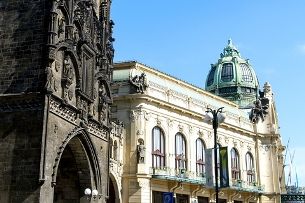During and after its construction, the Municipal House was criticized by pessimists, who considered its architecture to be old-fashioned. Today, we can only appreciate the sumptuous halls, where important political agreements were made, and admire the characteristic combination of the architectonic and art styles of turn of the 19th century.
“NeoBaroque, NeoRenaissance, and the Western and Oriental influences fuse together with Czech Art Nouveau,” says the official website of the Municipal House. It is not the only reason, however, why this symbol of the Czech statehood is worth your attention.
The royal history of the Municipal House
The Art Nouveau building of the Municipal House was ceremonially opened on 5 January 1912 after the Czech national revivalists urged the public to build a Czech social and cultural centre, similar to the German one. The chosen place could not be more respectable. The city adjudged a plot of land in the Old Town to the Municipal House, where the Royal House (Králův dvůr, a temporary residence of the Czech rulers) used to be in the 14th century and where the so-called Royal Route (Královská cesta, a historic path of the coronation parades) to the Prague Castle had its starting point.
The complex of the Royal House included the royal residence, a large garden, a menagerie, a spa and a church. Because of the construction of the Municipal House, the ruins of the complex were torn down and sacrificed on the altar of the “lighthouse of the Czech statehood”, as the Czechs called the long-desired Municipal House.
An overpriced shop window of the period art
The estimated cost of the original Municipal House project was 3 million crowns. The total expenses reached the staggering sum of 6 million. Despite the criticism and suspicions of corruption, the building brought together the best artists of that time: the Municipal House was decorated by painters Mikoláš Aleš, Václav Jansa, Alfons Mucha, Max Švabinský, and František Ženíšek. As for sculptors, we can mention Josef Mařatka or Josef Václav Myslbek.
Two historical turns in the Municipal House
The Municipal House was always one of the political centres in Prague. In this building, the establishment of the independent Czechoslovakia was declared on 28 October 1918, and the first meeting of the ruling communists and the representatives of the Civic Forum led by Václav Havel took place in November 1989. Both the events were turning points in the history of the Czech lands, and the Municipal House provided a respectable environment for many more.
The present-day Municipal House for the public
Today, concerts of classical music take place in the spacious halls of the Municipal House, but the rich programme also offers exhibitions of art and guided tours for tourists. The tours take about an hour and they can also be in English.
On the ground floor of the Municipal House, there is a French restaurant (opened in 1911), an originally furnished bar and an Art Nouveau café with a confectionary and a smaller gallery. In these shiny rooms with crystal chandeliers and marble, you can experience what was the atmosphere of the cream of the society like in the First Czechoslovak Republic.
How to get there
The Municipal House is situated in the south corner of náměstí Republiky Square, near Na Příkopě Street and the Powder Tower (Prašná brána). Náměstí Republiky Square is easily accessible by public transport; you can use the yellow metro B line or many buses and trams. Parking is complicated here, so either use public transport or take a walk in the city centre.





